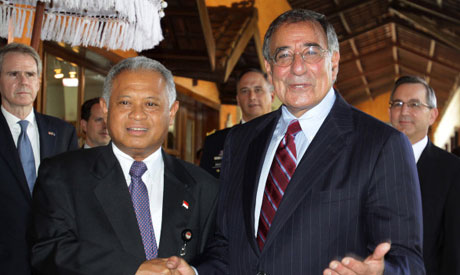
(Photo: AP)
Over the last few days, Former CIA chief and current U.S. Defense Secretary Leon Panetta trekked to Asia for a series of security meetings. Panetta first visited Indonesia, where he met Indonesian Defense Minister Purnomo Yusgiantoro (pictured above with Panetta). While in Bali, Panetta also visited the ten defense secretaries in town for an ASEAN meeting. He then moved on to meet with senior-level officials in Japan and South Korea, including Prime Minister Naoto Kan and President Lee Myung-bak.
This is the latest salvo in the Obama administration’s very public efforts to highlight the importance of Asia to American foreign policy. Just look at the effort that Secretary of State Hillary Clinton, just by herself, has invested in Asia. In less than three years on the job, Clinton has already traveled seven times to the region. She recently penned a lengthy article in Foreign Policy magazine, in which she outlined Washington’s intentions to devote substantially more diplomatic, economic, and security resources to Asia in the coming years. In a prior visit to Indonesia, in 2009, Clinton signed the Treaty of Amity and Cooperation on behalf of America.
But beyond Clinton, the U.S. more generally has taken on a more active role in Asia. It has upgraded its status in and commitment to Asian institutions like ASEAN and APEC. Washington just completed a much-valued trade deal with South Korea. America has launched the bilateral "Strategic and Economic Dialogue" with China, which is designed as a problem-solving workshop for the two countries. The U.S. has clearly beefed up its ties with India. America has worked to enhance its security and military ties to such countries as Australia and Singapore. And an An array of high-profile U.S. officials from the Obama administration have already visited Indonesia, including Panetta, former Defense head Robert Gates, Clinton, and Barack Obama. And Obama will be back there this November, when he participates in the upcoming East-Asia Summit.
What does all of these moves, including Panetta’s visit, mean?
First, Washington sees Asia as a crucial hub for a number of important, arguably global-defining, matters, including trade and finance issues, economic growth, security affairs, nuclear proliferation, cybersecurity, territorial and maritime disputes, climate change, and human rights.
Second, Obama wants to solidify America’s leadership in the region. The U.S. is now beginning to transition away from focusing so much on the Middle East. It’s soon ending its war in Iraq and in the process of drawing down its forces in Afghanistan. And in place of its near obsession with the politics and violence of the Middle East, the Obama administration wants to spend more time and energy to Asia.
Many American academics, journalists, bureaucrats, and elected officials, including Obama himself, seem convinced that the 21st century will be defined by countries like China, India, Japan, South Korea, and Indonesia.
This is an area of the world that can’t be ignored. Military might, economic growth, and population expansion–three key indicators of power–all tell us that power is likely, though not by no means definitively, shifting Eastward. If the U.S. is not fully engaged in the region, and is instead distracted and preoccupied with other world affairs, other parts of the world, then it risks having the world pass it by.
And lastly, we ought not forget the China factor. While there are some bureaucrats in Washington who fear the rise of China, the White House doesn’t. But it does have doubts and suspicions about China. And so the U.S. is pursuing a policy approach known widely as "hedged integration." It's been adopted by The White House, both Republican and Democratic administrations, for decades. According to David Lampton:
"The concrete manifestation of this policy has been the combination of "balance" and "integration", as Joseph Nye put it in a recent address at the Johns Hopkins School of Advanced International Studies. "Balance" refers to the use of all instruments of power, particularly hard instruments, to prevent the dominance of others, while "integration" refers to the use of all instruments of power, particularly soft ones, to bring China into an interdependent international system in which it hopefully will develop shared responsibility for system maintenance"
Hence, hedged integration works in two steps. First, U.S. has tried to envelop China in a web of interdependencies via a host of bilateral and multilateral ties. The prevailing wisdom is that these ties, mostly though not exclusively economic in nature, will make it too costly for China to wreck relations with the U.S. and other countries in Asia. Rather, these ties will push China toward supporting the international and regional status quo.
But just in case this doesn’t work, America has a back-up plan, a second step in its policy toward China. Over decades it has created, sustained, and enhanced security relations with many Asian countries. After all, consider the following. The U.S. has thousands of troops in the region, is a major supplier of arms and defense capabilities, and has good military contacts with its counterparts in Asia. This is the coercive element to America's approach to China and is done to keep China in check.
Clearly, Panetta’s visit can be seen in this light. While Clinton and Treasury Secretary Tim Geithner work to reassure China in various ways, Panetta looks to galvanize support from Asian defense officials for America. This alerts China that, despite its growing power, it faces constraints and limitations in Asia. It must not act too aggressively, because there’s potentially a counter-coalition of countries, U.S. included, that might confront Beijing.
*A more Indonesia-centric version of this blog post has been published in The Jakarta Globe. Here's the link: http://www.thejakartaglobe.com/opinion/in-asia-americas-back-up-plan/474035

No comments:
Post a Comment